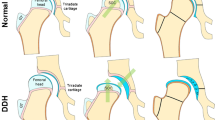Abstract
Purpose
The Haller index is an accepted CT method for evaluating thoracic dimensions in patients with pectus excavatum. The purpose of this study is to establish age- and gender-related norms for the Haller index in childhood.
Materials and methods
We retrospectively reviewed 574 consecutive chest CT examinations (M=285, F=289) performed at our institution from August 2001 through March 2002. Seventeen patients with a history of chest-wall deformity, trauma, or syndrome were excluded, for a total sample size of 557 patients. The Haller index was calculated for each patient, using electronic calipers. The sample population was then separated by gender and placed into 2-year age groupings. Two-way analysis of variance and Tukey’s multiple comparisons were performed to determine significance at a=0.05. The least-square mean Haller index values for each age group and gender were calculated with 95% confidence intervals.
Results
In both males and females, the 0- to 2-year age group showed a significantly smaller mean Haller index than older children. In addition, females had significantly greater Haller index values than males in the 0- to 6- and 12- to 18-year age groups.
Conclusion
The Haller index, a quantitative measurement of chest-wall configuration, demonstrates significant age- and gender-related variability. This should be considered when evaluating the patient with suspected chest-wall deformity.







Similar content being viewed by others
References
Nuss D, Kelly RE Jr, Croitoru DP, et al (1998) A 10-year review of a minimally invasive technique for the correction of pectus excavatum. J Pediatr Surg 33:545–552
Nuss D, Kelly RE Jr, Croitoru DP, et al (1998) Repair of pectus excavatum. Pediatric endosurgery and innovative techniques, vol 2, no. 4. Mary Ann Liebert, Larchmont
Ravitch MM (1949) The operative treatment of pectus excavatum. Ann Surg 129:429–444
Sidden CR, Katz ME, Swoveland BC, et al (2001) Radiologic considerations in patients undergoing the Nuss procedure for correction of pectus excavatum. Pediatr Radiol 31:429–434
Haller JA Jr, Kramer SS, Lietman SA (1987) Use of CT scans in selection of patients for pectus excavatum surgery: a preliminary report. J Pediatr Surg 22:904–908
Ohno K, Nakahira M, Takeuchi S, et al (2001) Indications for surgical treatment of funnel chest by chest radiograph. Pediatr Surg Int 17:591–595
Author information
Authors and Affiliations
Corresponding author
Additional information
This manuscript was presented as a poster at the 2002 RSNA Annual Convention and Scientific Assembly
Rights and permissions
About this article
Cite this article
Daunt, S.W., Cohen, J.H. & Miller, S.F. Age-related normal ranges for the Haller index in children. Pediatr Radiol 34, 326–330 (2004). https://doi.org/10.1007/s00247-003-1116-1
Received:
Revised:
Accepted:
Published:
Issue Date:
DOI: https://doi.org/10.1007/s00247-003-1116-1




